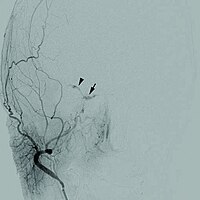
Photo from wikipedia
Objective To determine that children with arterial ischemic stroke (AIS) due to an identifiable arteriopathy are distinct from those without arteriopathy and that each arteriopathy subtype has unique and recognizable… Click to show full abstract
Objective To determine that children with arterial ischemic stroke (AIS) due to an identifiable arteriopathy are distinct from those without arteriopathy and that each arteriopathy subtype has unique and recognizable clinical features. Methods We report a large, observational, multicenter cohort of children with AIS, age 1 month to 18 years, enrolled in the International Pediatric Stroke Study from 2003 to 2014. Clinical and demographic differences were compared by use of the Fisher exact test, with linear step-up permutation min-p adjustment for multiple comparisons. Exploratory analyses were conducted to evaluate differences between cases of AIS with and without arteriopathy and between arteriopathy subtypes. Results Of 2,127 children with AIS, 725 (34%) had arteriopathy (median age 7.45 years). Arteriopathy subtypes included dissection (27%), moyamoya (24.5%), focal cerebral arteriopathy–inflammatory subtype (FCA-i; 15%), diffuse cerebral vasculitis (15%), and nonspecific arteriopathy (18.5%). Children with arteriopathic AIS were more likely to present between 6 and 9 years of age (odds ratio [OR] 1.93, p = 0.029) with headache (OR 1.55, p = 0.023), multiple infarctions (OR 2.05, p < 0.001), sickle cell anemia (OR 2.9, p = 0.007), and head/neck trauma (OR 1.93, p = 0.018). Antithrombotic use and stroke recurrence were higher in children with arteriopathy. Among arteriopathy subtypes, dissection was associated with male sex, older age, headache, and anticoagulant use; FCA-i was associated with hemiparesis and single infarcts; moyamoya was associated with seizures and recurrent strokes; and vasculitis was associated with bilateral infarctions. Conclusion Specific clinical profiles are associated with cerebral arteriopathies in children with AIS. These observations may be helpful indicators in guiding early diagnosis and defining subgroups who may benefit most from future therapeutic trials.
Journal Title: Neurology
Year Published: 2020
Link to full text (if available)
Share on Social Media: Sign Up to like & get
recommendations!